Hellstorm: Exposing The Real Genocide Of Hitler's Germany
+4
Spöket
Admin
de Valle
Thinkforyourself
8 posters
IFERS - Exposing the 'Global' Conspiracy From Atlantis to Zion :: NASA, UN, Freemasonry, Vatican, Jews, Jesuits, NWO
Page 1 of 1
 Hellstorm: Exposing The Real Genocide Of Hitler's Germany
Hellstorm: Exposing The Real Genocide Of Hitler's Germany
Posted by Admin on 05/10/2015
I personally think this is the most important and well-made documentary about the most important subject other than the flat Earth! This documentary tells the tale that the victors still do not want you to know. Learn the terrible truth about the rape, torture, slavery, and mass murder inflicted upon the German people by the Allied victors of World Word II.
Buy The Book: www.amazon.com/Hellstorm-Death-Nazi-Germany-1944-1947/dp/1494775069
Website: www.hellstormdocumentary.com/
Quotations & Sources: www.hellstormdocumentary.com/quotes/
I personally think this is the most important and well-made documentary about the most important subject other than the flat Earth! This documentary tells the tale that the victors still do not want you to know. Learn the terrible truth about the rape, torture, slavery, and mass murder inflicted upon the German people by the Allied victors of World Word II.
Buy The Book: www.amazon.com/Hellstorm-Death-Nazi-Germany-1944-1947/dp/1494775069
Website: www.hellstormdocumentary.com/
Quotations & Sources: www.hellstormdocumentary.com/quotes/
_________________
All about Shillaphobia
Shun the non-believers!
'Flat Earth Diva'
Supposed 'temper temper beanpole', 'snidy weasel' and 'clueless, cloying, sychophant.'
Apparently 'dangerous person'
Thinkforyourself- Admin
- Posts : 2048
Points : 8347
Reputation : 2862
Join date : 2015-12-30
Age : 36
Location : United Kingdom
 Re: Hellstorm: Exposing The Real Genocide Of Hitler's Germany
Re: Hellstorm: Exposing The Real Genocide Of Hitler's Germany
Posted by Admin on 05/10/2015
When people have more time to dedicate to researching this issue, please also watch/read the following:
The Zionist Jew World Order
Jewish Ritual Sacrifice
When people have more time to dedicate to researching this issue, please also watch/read the following:
The Zionist Jew World Order
Jewish Ritual Sacrifice
_________________
All about Shillaphobia
Shun the non-believers!
'Flat Earth Diva'
Supposed 'temper temper beanpole', 'snidy weasel' and 'clueless, cloying, sychophant.'
Apparently 'dangerous person'
Thinkforyourself- Admin
- Posts : 2048
Points : 8347
Reputation : 2862
Join date : 2015-12-30
Age : 36
Location : United Kingdom
 Re: Hellstorm: Exposing The Real Genocide Of Hitler's Germany
Re: Hellstorm: Exposing The Real Genocide Of Hitler's Germany
Posted by Admin on 05/21/2015
_________________
All about Shillaphobia
Shun the non-believers!
'Flat Earth Diva'
Supposed 'temper temper beanpole', 'snidy weasel' and 'clueless, cloying, sychophant.'
Apparently 'dangerous person'
Thinkforyourself- Admin
- Posts : 2048
Points : 8347
Reputation : 2862
Join date : 2015-12-30
Age : 36
Location : United Kingdom
 Re: Hellstorm: Exposing The Real Genocide Of Hitler's Germany
Re: Hellstorm: Exposing The Real Genocide Of Hitler's Germany
Posted by lizardking on 05/22/2015
They're the most victimised nation of Zionist oppression. Many of them do speak out, but it is a hugely controversial subject, and in Germany leads to prison sentences. Still, many Germans do strike on that subject and there are certain parts of Germany which are more revisionist than not, but seeing as it is a criminal offence, there is not much that they can do.
May 21, 2015 18:01:40 GMT Joseph said:
Why haven't the Germans spoken out against this lie?
They're the most victimised nation of Zionist oppression. Many of them do speak out, but it is a hugely controversial subject, and in Germany leads to prison sentences. Still, many Germans do strike on that subject and there are certain parts of Germany which are more revisionist than not, but seeing as it is a criminal offence, there is not much that they can do.
_________________
All about Shillaphobia
Shun the non-believers!
'Flat Earth Diva'
Supposed 'temper temper beanpole', 'snidy weasel' and 'clueless, cloying, sychophant.'
Apparently 'dangerous person'
Thinkforyourself- Admin
- Posts : 2048
Points : 8347
Reputation : 2862
Join date : 2015-12-30
Age : 36
Location : United Kingdom
 Re: Hellstorm: Exposing The Real Genocide Of Hitler's Germany
Re: Hellstorm: Exposing The Real Genocide Of Hitler's Germany
Posted by Admin on 05/22/2015


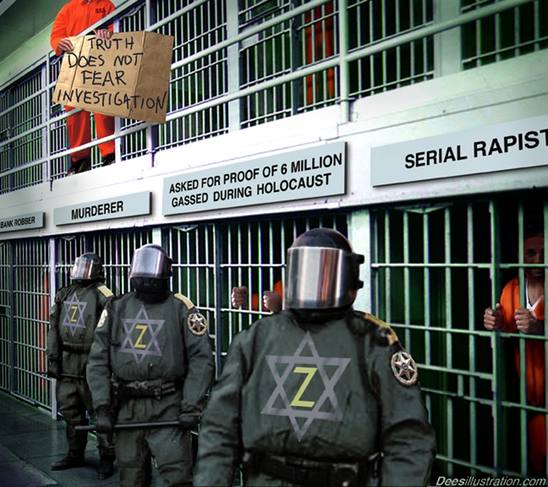






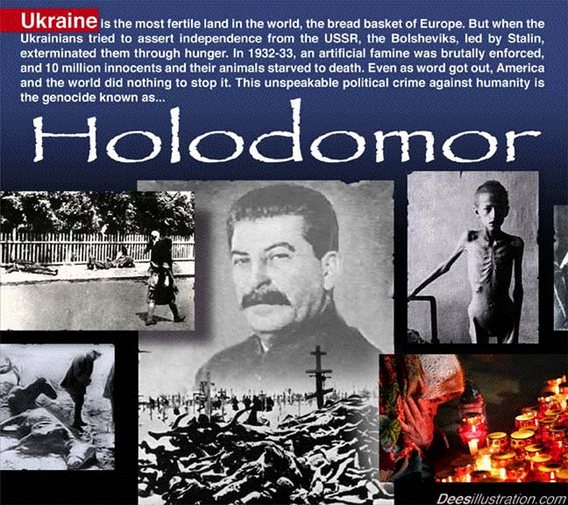

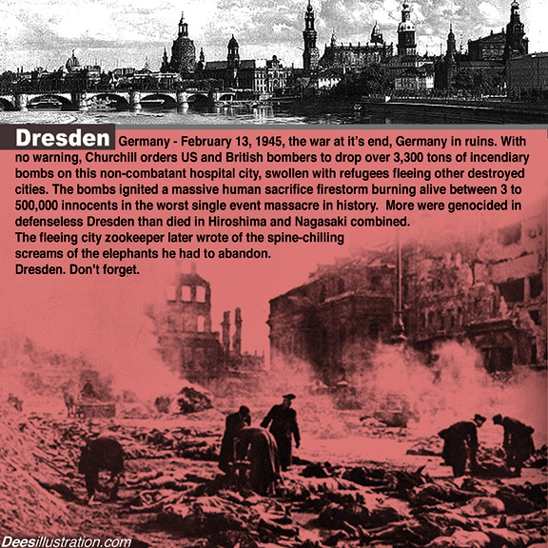











_________________
All about Shillaphobia
Shun the non-believers!
'Flat Earth Diva'
Supposed 'temper temper beanpole', 'snidy weasel' and 'clueless, cloying, sychophant.'
Apparently 'dangerous person'
Thinkforyourself- Admin
- Posts : 2048
Points : 8347
Reputation : 2862
Join date : 2015-12-30
Age : 36
Location : United Kingdom
 Re: Hellstorm: Exposing The Real Genocide Of Hitler's Germany
Re: Hellstorm: Exposing The Real Genocide Of Hitler's Germany
Posted by thinkforyourself on 05/27/2015
May 13, 2015 16:17:40 GMT sneezuschrist said:
Watched the first half of Hellstorm last night with the gf who thought shed hate it by the time we stopped she was so distraught about what happened and knowing so little. Really touched her in a way she wasnt expecting. Looking forward to sharing more of this.
Did you ever watch the rest of the film? It is shocking how badly the Germans have been treated and how often they have been attacked, when the Holocaust never happened.
I suggest that you also watch 'The Greatest Story Never Told', which shows that Hitler was actually someone trying to save his people from the evil Zionist NWO. It is such a shame that he failed in the end.
May 13, 2015 16:17:40 GMT sneezuschrist said:
Watched the first half of Hellstorm last night with the gf who thought shed hate it by the time we stopped she was so distraught about what happened and knowing so little. Really touched her in a way she wasnt expecting. Looking forward to sharing more of this.
Did you ever watch the rest of the film? It is shocking how badly the Germans have been treated and how often they have been attacked, when the Holocaust never happened.
I suggest that you also watch 'The Greatest Story Never Told', which shows that Hitler was actually someone trying to save his people from the evil Zionist NWO. It is such a shame that he failed in the end.
_________________
All about Shillaphobia
Shun the non-believers!
'Flat Earth Diva'
Supposed 'temper temper beanpole', 'snidy weasel' and 'clueless, cloying, sychophant.'
Apparently 'dangerous person'
Thinkforyourself- Admin
- Posts : 2048
Points : 8347
Reputation : 2862
Join date : 2015-12-30
Age : 36
Location : United Kingdom
 Re: Hellstorm: Exposing The Real Genocide Of Hitler's Germany
Re: Hellstorm: Exposing The Real Genocide Of Hitler's Germany
Eisenhower’s Rhine Meadows Death Camps
Beginning in early childhood education, we are brainwashed into believing the false narrative that the WWII Allies were locked in a struggle of good vs evil with Hitler being the devil incarnate and America acting so honorably in saving Europe from Hitler's planned Thousand-Year Reich. We hear about Nazi concentration camps ad nauseam from whiney jews who perpetuate the myth for financial gain and promotion of their own ethnic self interests at the expense of the gentile majority. The WWII Germans were the victims of a real holocaust in Dresden and subjected to sub-human treatment at the hands of bloodthirsty Allied Zionists after the war.
America happened to have their very own post-war "Hitler" in Dwight Eisenhower, who in 1945 established a series of 19 barbaric internment camps to house surrendered German POW's. Eisenhower unlawfully classified the German prisoners as Disarmed Enemy Forces (DEF's) in order to deprive them of protection under the 1929 Geneva Convention and to circumvent laws regarding the use of POW's as forced labor. Nearly one million Germans died in these open air camps due to exposure to the elements, starvation and disease due to the absence of sanitary facilities.

Eisenhower was a supporter of jewish Treasury Secretary Henry Morgenthau, Jr.'s draconian and retributive Morgenthau Plan to destroy what little remained of Germany's infrastructure after the war and permanently remove Germany's industrial capacity to wage future wars. Eisenhower was promoted and supported in his career by abhorrent mega-Zionist Bernard Baruch. Baruch used his inordinate power to elevate Eisenhower to Supreme Allied Commander in Europe over many better qualified men, which favor he repaid in his genocidal assault on the German people after World War II. As president, he used his powers to advance the cause of the jewish state©.
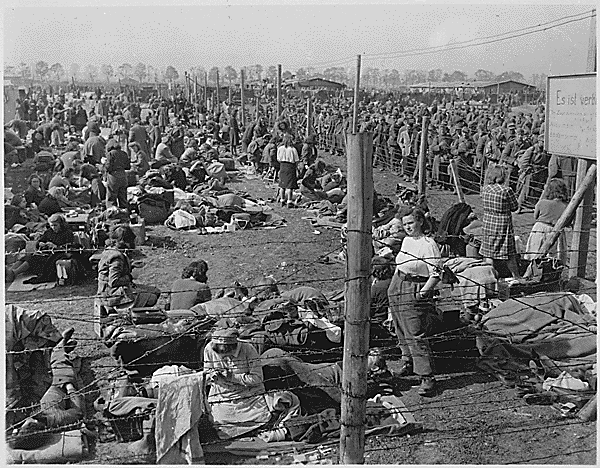
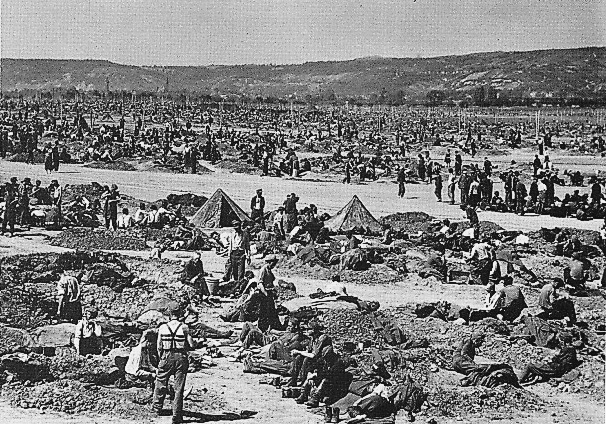

Throughout the summer of 1945, the International Committee of the Red Cross (ICRC) was prevented from visiting prisoners in any of the Allies' Rheinwiesenlager. Visits only started February 4, 1946 when the Red Cross was allowed to send relief to those in the U.S. run occupation zone, at a time when most camps had closed or were closing. The International Red Cross website states "The quantities received by the ICRC for these captives remained very small, however. During their visits, the delegates observed that German prisoners of war were often detained in appalling conditions.
First hand observations regarding Conditions in the camps are provided through a few excerpts below from James Bacque's Saturday Night magazine article, Eisenhower's Death Camps - The Last Dirty Secret of World War Two:
George Weiss, at tank repairman who now lives in Toronto, recalls of his camp on the Rhine: "All night we had to sit up jammed against each other. But the lack of water was the worst thing of all. For three and a half days, we had no water at all. We would drink our own urine...."
Private Heinz T. had just turned 18 in hospital when the Americans walked into his ward on April 18. He and all his fellow patients were taken out to the camp at Bad Kreuzpath in the Rhineland, which already held several hundred thousand prisoners. Heinz was wearing only a pair of shorts, shoes, and a shirt.
Heinz was far from the youngest in the camp, which also held thousands of displaced German civilians. There were children as young as six among the prisoners, as well as pregnant women, and men over sixty. At the beginning, when trees still grew in the camp, some men managed to cut off limbs to build a fire. The guards ordered the fire put out. In many of the enclosures, it was forbidden to dig holes in the ground for shelter. "All we had to eat was grass," Heinz remembers.
Charles von Luttichau was convalescing at home when he decided to surrender voluntarily to US troops about to occupy his house. He was taken to Camp Kripp, on the Rhine near Remagen. He was in the Kripp camp for about three months.
"We were kept in crowded barbed wire cages in the open with scarcely any food," he recalled recently. "More than half the days we had no food at all. On the rest, we got a little K ration. I could see from the package that they were giving us one-tenth of the rations that they issued to their own men....I complained to the American camp commander that he was breaking the Geneva Convention, but he just said, 'Forget the Convention. You haven't any rights.'
"The latrines were just logs flung over ditches next to the barbed-wire fences. Because of illness, the men had to defecate on the ground. Soon, many of us were too weak to take our trousers off first. So our clothing was infected, and so was the mud where we had to walk and sit and lie down. In these conditions, our men very soon started to die. Within a few days, some of the men who had gone healthy into the camp were dead. I saw our men dragging many bodies to the gate of the camp, where they were thrown loose on top of each other onto trucks, which took them away."
Wolfgang Iff, who was imprisoned at Rheinberg and still lives in Germany, reports that, in his subsection of perhaps 10,000 prisoners, thirty to fifty bodies were dragged out every day. A member of the burial work party, Iff says he helped haul the dead from his cage out to the gate of the camp, where the bodies were carried by wheel barrow to several big steel garages. There Iff and his team stripped the corpses of clothing, snapped off half of their aluminum dog tag, spread the bodies in layers of fifteen to twenty, with ten shovelfuls of quicklime over each layer till they were stacked a meter high, placed the personal effects in a bag for the Americans, then left. Some of the corpses were dead of gangrene following frostbite. (It was an unusually wet, cold spring.) A dozen or more others had grown too weak to cling to the log flung across the ditch for a latrine, and had fallen off and drowned.
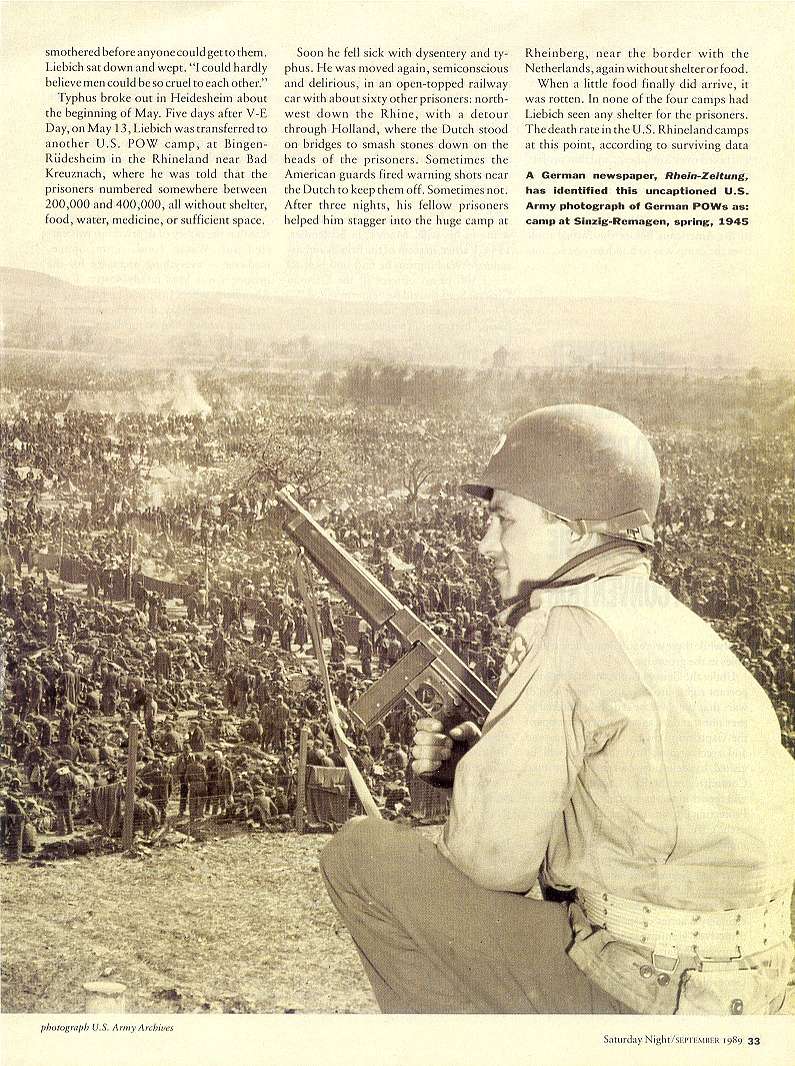
The conditions in the American camps along the Rhine in late April were observed by two colonels in the U.S. Army Medical Corps, James Mason and Charles Beasley, who described them in a paper published in 1950: "Huddled close together for warmth, behind the barbed wire was a most awesome sight--nearly 100,000 haggard, apathetic, dirty, gaunt, blank-staring men clad in dirty field grey uniforms, and standing ankle-deep in mud....The German Divisions Commander reported that the men had not eaten for at least two days, and the provisions of water was a major problem--yet only 200 yards away was the River Rhine running bankfull."
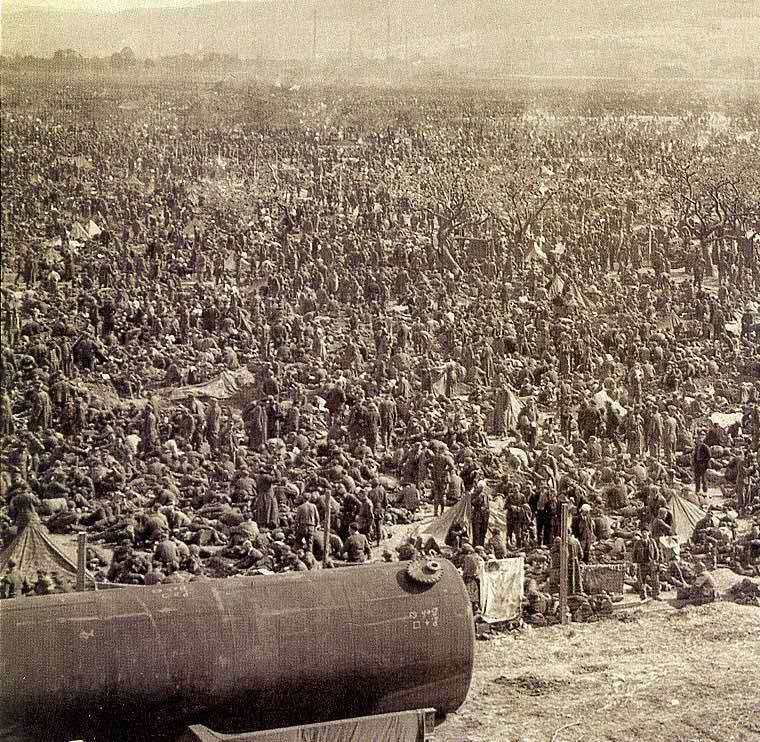
In May and early June of 1945, a team of US Medical Corps doctors did survey some of the Rhineland camps. They found the three main killers were diarrhea and dysentery (treated as one category), cardiac disease, and pneumonia. But, straining medical terminology, the doctors also recorded deaths from "emaciation" and "exhaustion." And their data revealed death rates eighty times as high as any peacetime norm. By the end of May 1945, more people had already died in the US camps than would die in the atomic blast at Hiroshima.
On July 10, 1945, a French unit took over Dietersheim and 17 days later a Captain Julien arrived to assume command. His report survives as part of an army inquiry into a dispute between Julien and his predecessor. In the first camp he entered, he testified to finding a vast mire "peopled with living skeletons," some of whom died as he watched.
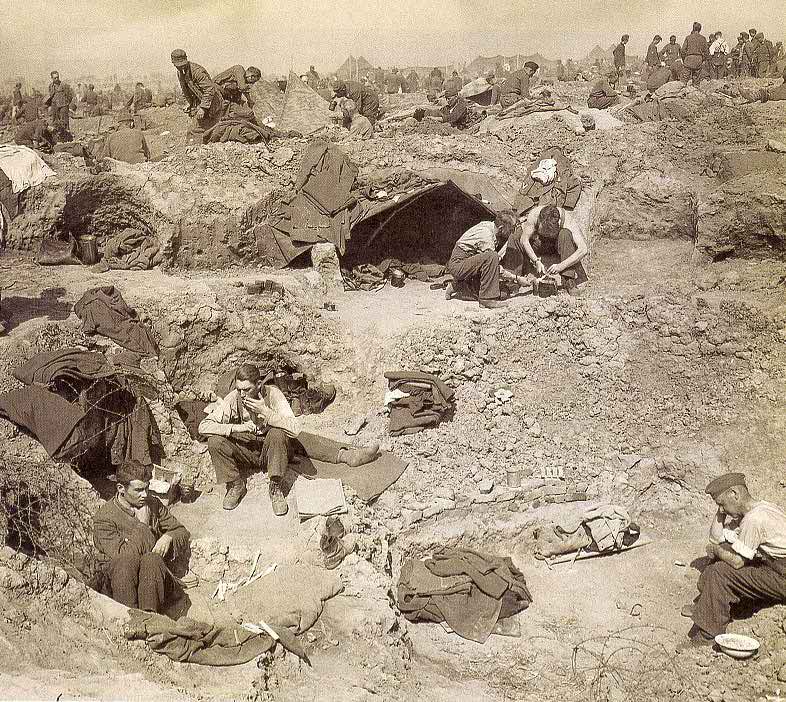
Remember, these Rhine Meadow camps had absolutely "no shelter or other comforts", per U.S. policy. The prisoners were forced to live in holes the the earth that they dug themselves. Contrast this with Auschwitz, who's amenities included a swimming pool, soccer pitch, dental & medical facilities, 12 kitchens with caloric food content monitored by the Red Cross, several camp orchestras, camp theater, camp art classes with a museum where their artwork was displayed, camp cinema, camp library, a canteen from which to purchase limited foodstuffs, cigarettes and postage stamps and a camp brothel.

Eisenhower transferred several hundred thousands of POW's to the jewish-Bolshevick Soviets which used them, alongside Soviet captured POW's and German civilians, as forced laborers. Also starting in July 1945, the Americans turned over between 600,000 and 700,000 German captives to the French to be used as forced labor to help repair damages done to their country during the war.


"I found around me, particularly Morgenthau, a very bitter atmosphere of personal resentment against the entire German people without regard to individual guilt and I am very much afraid that it will result in our taking mass vengeance on the part of our people in the shape of clumsy economic action."
—Secretary of War Henry L. Stimson
"We have got to be tough with Germany and I mean the German people, not just the Nazis. You either have to castrate the German people or you have got to treat them in such a manner so they can't go on reproducing people who want to continue the way they have in the past."
—Franklin Roosevelt
"The German people must not be allowed to escape a personal sense of guilt. Germany's war-making power should be eliminated.. Certain groups should be specifically punished.. The German General Staff should be utterly eliminated. All records destroyed and individuals scattered and rendered powerless to operate as body."
—Dwight D. Eisenhower
Further Resources:
http://www.telegraph.co.uk/culture/books/3664526/How-three-million-Germans-died-after-VE-Day.html
http://www.erichufschmid.net/TFC/Eisenhower-death-camps.html
http://www.ihr.org/jhr/v10/v10p161_Brech.html
http://www.rense.com/general46/germ.htm
http://www.whale.to/b/bacque1.html (transcription of Saturday Night article)
http://justice4germans.com/2013/08/21/documentary-eisenhowers-rhine-meadows-death-camps-a-deliberate-policy-of-extermination
http://www.hist-chron.com/eu/D/1945-rheinwiesenlager/ENGL/001-basics.html (has 6 total parts)
http://holocaust-of-world-war-two.blogspot.com
http://holocaust-of-world-war-two.blogspot.com/2014/11/the-tragic-fate-of-german-pows-and_24.html
http://holocaust-of-world-war-two.blogspot.com/2015/07/harrowing-and-touching-report-by-german.html

de Valle- Posts : 4
Points : 3273
Reputation : 15
Join date : 2015-12-31
 Re: Hellstorm: Exposing The Real Genocide Of Hitler's Germany
Re: Hellstorm: Exposing The Real Genocide Of Hitler's Germany
Eisenhower's Death Camps
The Last Dirty Secret of World War Two
by James Bacque
Saturday Night
Sept 1989
Call it callousness, call it reprisal, call it a policy of hostile neglect: a million Germans taken prisoner by Eisenhower's armies died in captivity after the surrender.
In the spring of 1945, Adolph Hitler's Third Reich was on the brink of collapse, ground between the Red Army, advancing westward towards Berlin, and the American, British, and Canadian armies, under the overall command of General Dwight Eisenhower, moving eastward over the Rhine. Since the D-Day landings in Normandy the previous June, the westward Allies had won back France and the Low Countries, and some Wehrmacht commanders were already trying to negotiate local surrenders. Other units, though, continued to obey Hitler's orders to fight to the last man. Most systems, including transport, had broken down, and civilians in panic flight fromt he advancing Russians roamed at large.
"Hungry and frightened, lying in grain fields within fifty feet of us, awaiting the appropriate time to jump up with their hands in the air"; that's how Captain H. F. McCullough of the 2nd Anti-Tank Regiment Division described the chaos of the German surrender at the end of the Second World War. In a day and a half, according to Field Marshall Bernard Montgomery, 500,000 Germans surrendered to his 21st Army Group in Northern Germany. Soon after V-E Day--May 8, 1945--the British-Canadian catch totalled more that 2 million. Virtually nothing about their treatment survives in the archives in Ottawa or London, but some skimpy evidence from the International Committee of the Red Cross, the armies concerned, and the prisoners themselves indicates that almost all continued in fair health. In any case, most were quickly released and sent home, or else transferred to the French to help in the post-war work of reconstruction. The French army had itself taken fewer than 300,000 prisoners.
Like the British and Canadians, the Americans suddenly faced astounding numbers of surrendering German troops: the final tally of prisoners taken by the U.S. army in Europe (excluding Italy and North Africa) was 5.25 million. But the Americans responded very differently.
Among the early U.S captives was one Corporal Helmut Liebich, who had been working in an anti-aircraft experimental group at Peenemunde on the Baltic. Liebich was captured by the Americans on April 17, near Gotha in Central Germany. Forty-two years later, he recalled vividly that there were no tents in the Gotha camp, just barbed wire fences around a field soon churned to mud. The prisoners received a small ration of food on the first day but it was then cut in half. In order to get it, they were forced to run a gauntlet. Hunched ocer, they ran between lines of American guards who hit them with sticks as they scurried towards their food. On April 27, they were transferred to the U.S. camp at Heidesheim farther wet, where there was no food at all for days, then very little. Exposed, starved, and thirsty, the men started to die. Liebich saw between ten and thirty bodies a day being dragged out of his section, B, which at first held around 5,200 men.. He saw one prisoner beat another to death to get his piece of bread. One night when it rained, Liebich saw the sides of the holes in which they were sheltered, dug in soft sandy earth, collapse on men who were too weak to struggle out. They smothered before anyone could get to them. Liebich sat down and wept. "I could hardly believe men could be so cruel to each other."
Typhus broke out in Heidesheim about the beginning of May. Five days after V-E Day, on May 13, Liebich was transferred to another U.S. POW camp, at Bingen-Rudesheim in the Rhineland near Bad Kreuznach, where he was told that the prisoners numbered somewhere between 200,000 and 400,000, all without shelter, food, water, medicine, or sufficient space.
Soon he fell sick with dysentery and typhus. he was moved again, semiconscious and delirious, in an open-topped railway car with about sixty other prisoners: northwest down the Rhine, with a detour through Holland, where the Dutch stood on bridges to smash stones down on the heads of the prisoners. Sometimes the American guards fired warning shots near the Dutch to keep them off. After three nights, his fellow prisoners helped him stagger into the hug camp at Rheinberg, near the border with the Netherlands, again without shelter or food.
When a little food finally did arrive, it was rotten. In none of the four camps had Leibich seen any shelter for the prisoners. the death rate in the U.S. Rhineland camps at this point, according to surrviving data from a medical survey, was about thirty per cent per year. A normal death rate for a civilian population in 1945 was between one and two percent.
One day in June, through hallucinations of his fever, Liebich saw "the Tommies" coming into the camp. The British had taken over Rheinberg, and that probably saved his life. At this point, Liebich, who is five-foot-ten, weighed 96.8 ponds.
According to stories told to this day by other ex-prisoners of Rheinberg, tha last act of the Americans before the British took over was to bulldoze one section level while there were still men living in their holes in the ground.
Under the Geneva Convention, three important rights are guaranteed prisoners of war: that they will be fed and sheltered to the same standard as base or depot troops of the Capturing Power; that they can send and receive mail; and that they will be visited by delegates of the International Red Cross (ICRC) who will report in secret on their treatment to a Protecting Power. (In the cas eof Germany, as the government disintegrated in the closing stages of the war, Switzerland had been designated the protecting power.)
In fact, German prisoners taken by the U.S. Army at the end of the Second World War were denied these and most other rights by a series of specific decisions and directives stemming mainly from SHAEF--Supreme Headquarters, Allied Expeditionary Force. General Dwight Eisenhower was both supreme commander of SHAEF--all the Allied armies in northwest Europe--and the commanding general of the U.S. forces in the European theatre. He was subject to the Combined Chiefs of Staff (CCS) of Britain and the U.S., to the U.S. Joint Chiefs of Staff (JCS), and to the policy of the U.S. government, but in the absence of explicit directives--to the contrary or otherwise--ultimate responsibility for the treatment of the German prisoners in American hands lies with him.
"God , I hate the Germans," Eisenhower wrote to his wife, Mamie, in September, 1944. Earlier, in front of the British ambassador to Washington, he had said that all the 3,500 or so officers of the German General Staff should be "exterminated."
In March, 1945, a message to the Combined Chiefs of Staff signed and initialled by Eisenhower recommended creating a new class of prisoners--Disarmed Enemy Forces, or DEFs--who, unlike Geneva-defined prisoners of war, would not be fed by the army after the surrender of Germany. This would be a direct breach of the Geneva Convention. The message, dated March 10, argues in part: "The additional maintenance commitment entailed by declaring the German Armed Forces prisoners [sic] of war which would necessitate the prevision of rations on a scale equal to that of base troops would prove far beyond the capacity of the Allies even if all German sources were tapped." It ends: "Your approval is requested. Existing plans have been prepared upon this basis."
On April 26, 1945, the Combined Chiefs approved the DEF status for prisoners of war in American hands only: the British members had refused to adopt the American plan for their own prisoners. The Combined Chiefs stipulated that the status of disarmed troops be kept secret.
By that time, Eisenhower's quartermaster general at SHAEF, General Robert Littlejohn, had already twice reduced rations for prisoners, and a SHAEF message signed "Eisenhower" had reported to General George Marshall, the U.S. Army Chief of staff, that the prisoner pens would provide "no shelter or other comforts...."
The problem was not supplies. There was more than enough material stockpiled in Europe to construct prison camp facilities. Eisenhower's special assistant, general Everett Hughes, had visited the huge supply dumps at Naples and Marseille and reported: "More stocks than we can ever use. Stretch as far as eye can see." Food should not have been a problem, either. In the U.S., wheat and corn surpluses were higher than they had ever been, and there was a record crop of potatoes. The army itself had so much food in reserve that when a whole warehouse was dropped from the supply list by accident in England it was not noticed for three months. In addition, the International Red Cross had over 100,000 tons of food in storage in Switzerland. When it tried to send two trainloads of this to the American sector of Germany, U.S. Army Officers turned the trains back, saying their warehouses were already overflowing with ICRC food which they had never distributed.
Nonetheless it was through the supply side that the policy of deprivation was carried out. Water, food, tents, space, medicine--everything necessary for the prisoners was kept fatally scarce. Camp Rheinberg, where Corporal Liebich would fetch up in in mid-May, shivering with dysentery and typhus, had no food at all when it was opened on April 17. As in the other big "Rhine meadow" camps, opened by the Americans in mid-April, there were no guard towers, tents, buildings, cooking facilities, water, latrines, or food.
George Weiss, at tank repairman who now lives in Toronto, recalls of his camp on the Rhine: "All night we had to sit up jammed against each other. But the lack of water was the worst thing of all. For three and a half days, we had no water at all. We would drink our own urine...."
Private Heinz T. (his surname is withheld at his request) had just turned eighteen in hospital when the Americans walked into his ward on April 18. he and all his fellow patients were taken out to the camp at Bad Kreuzpath in the Rhineland, which already held several hundred thousand prisoners. Heinz was wearing only a pair of shorts, shoes, and a shirt.
Heinz was far from the youngest in the camp, which also held thousands of displaced German civilians. there were children as young as six among the prisoners, as well as pregnant women, and men over sixty. At the beginning, when trees still grew i the camp, some men managed to cut off limbs to build a fire. the guards ordered the fire put out. In many of the enclosures, it was forbidden to dig holes in the ground for shelter. "All we had to eat was grass," Heinz remembers.
Charles von Luttichau was convalescing at home when he decided to surrender voluntarily to US troops about to occupy his house. He was taken to Camp Kripp, on the Rhine near Remagen.
"We were kept in crowded barbed wire cages in the open with scarcely any food," he recalled recently. "More than half the days we had no food at all. On the rest, we got a little K ration. I could see from the package that they were giving us one-tenth of the rations that they issued to their own men....I complained to the American camp commander that he was breaking the Geneva Convention, but he just said, 'Forget the Convention. You haven't any rights.'
"The latrines were just logs flung over ditches next to the barbed-wire fences. Because of illness, the men had to defecate on the ground. Soon, many of us were too weak to take our trousers off first. So our clothing was infected, and so was the mud where we had to walk and sit and lie down. In these conditions, our men very soon started to die. Within a few days, some of the men who had gone healthy into the camp were dead. I saw our men dragging many bodies to the gate of the camp, where they were thrown loose on top of each other onto trucks, which took them away."
Von Luttichau's mother was American and he later emigrated to Washington, D.C., where he became a historian and wrote a military history for the U.S. Army. he was in the Kripp camp for about three months.
Wolfgang Iff, who was imprisoned at Rheinberg and still lives in Germany, reports that, in his subsection of perhaps 10,000 prisoners, thirty to fifty bodies were dragged out every day. A member of the burial work party, Iff says he helped haul the dead from his cage out to the gate of the camp, where the bodies were carried by wheel barrow to several big steel garages. there Iff and his team stripped the corpses of clothing, snapped off half of their aluminium dog tag, spread the bodies in layers of fifteen to twenty, with ten shovelfuls of quicklime over each layer till they were stacked a metre high, placed the personal efefcts in a bag for the Americans, then left. Some of the corpses were dead of gangrene following frostbite. (It was an unusually wet, cold spring.) A dozen or more others had grown too weak to cling to the log flung across the ditch for a latrine, and had fallen off and drowned.
The conditions in the American camps along the Rhine in late April were observed by two colonels in the U.S. Army Medical Corps, James Mason and Charles Beasley, who described them in a paper published in 1950: "Huddled close together for warmth, behind the barbed wire was a most awesome sight--nearly 100,000 haggard, apathetic, dirty, gaunt, blank-staring med clad in dirty field grey uniforms, and standing ankle-deep in mud....The German Divisions Commander reported that the men had not eaten for at least two days, and the provisions of water was a major problem--yet only 200 yards away was the River Rhine running bankfull."
On May 4, 1945, the first German prisoners of war in U.S. hands were transferred to DEF status. The same day, the U.S. war Department banned mail to or from the prisoners. (when the International Committee of the Red Cross suggested a plan for restoring mail in June, it was rejected.)
On May 8, V-E Day, the German government was abolished and, simultaneously, the U.S. State Department dismissed Switzerland as the protecting power for the German prisoners. (Prime Minister Mackenzie King of Canada protested to the foreign Office in London the parallel removal of the Swiss as protecting power in British-Canadian camps, but was squelched for his pains.) With this done, the State Department informed the International Red Cross that, since there was no protecting power to report to, there was no longer and point in visiting the camps.
From then on, prisoners held by the US Army had no access to any impartial observer, nor could they receive food parcels, clothing, or medicines from any relief agency, or letters from their kin.
general George Patton's US Third Army was the only army in the whole European theatre to free significant numbers of captives during ma, saving many of them from probable death. Bothe Omar Bradley and General J.C.H. lee, Commander Communications Zone (Com Z) Europe, ordered a release of prisoners within a week of the war's end, but a SHAEF order signed "Eisenhower" countermanded them on my 15.
That same day, according to a minute of their meeting, General Eisenhower and Prime Minister Churchill talked about reducing prisoner rations. Churchill asked for an agreement on the scale of rations for prisoners, because he would soon have to announce cuts in the British meat ration and wanted to make sure that the prisoners "as far as possible...should be fed on those supplies which we could best spare." Eisenhower replied that he had already "given the matter considerable attention," but was planning to re-examine the whole thing to see "whether or not a further ereduction was possible." He told Churchill that POWs had been getting 2,200 calories a day. (The US Army medical Corps considered 2,150 an absolute minimum subsistence level for sedentary adults living under shelter. US troops were issued 4,000 calories a day.) What he did not tell Churchill was that the army was not feeding the DEFs at all, or was feeding them far less than those who still enjoyed prisoner-of-war status.
Rations were reduced again soon after this: a direct cut was recorded in the Quartermaster Reports. But indirect cuts were taking place as well. One was the effect of extraordinary gaps between prisoner strength as given on the ration lists and official "on hand" accounts, and between the on-hand counts, and between the on-hand count and the actual number of prisoners in the camps.
The meticulous General Lee grew so worried about the discrepancies that he fired off a challenging cable from his headquarters in paris to SHAEF headquarters in Frankfurt:
"This Headquarters is having considerable difficulty in establishing adequate basis for requisitioning rations for prisoners of war currently held in Theatre...In response to inquiries from this Headquarters...several varying statements of number of prisoners held in theatre have been published by SHAEF."
He then cites the latest SHAEF statement:
"Cable...dated 31 May states 1,890,000 prisoners of war and 1,200,000 disarmed German forces on hand. Best available figures at this Headquarters show prisoners of war in ComZ910,980, in ComZ transient enclosures 1,002,422 and in Twelfth Army GP 965,125, making a total of 2,878,537 and an additional 1,000,000 disarmed German forces Germany and Austria."
The situation was astounding: Lee was reporting a million or more men in the US Army camps in Europe than SHAEF said it ha don its books. But he was wrestling with the wind: he had to his issue of food on the number of prisoners on hand supplied to him by SHAEF G-3 (Operations).
Given the general turmoil, fluctuating and inaccurate tallies were probably inevitable, but more than 1 million captives can actual be seen disappearing between two reports of the Theatre Provost Marshal, issued on the same day, June2. the last in a series of daily reports from the TPM logs 2,870,400 POWs on hand at June 2. The first report of the new weekly series, dated the same day, says that there are only 1,836,000 on hand. At one point in the middle of June, the prisoner strength on the ration list was shown as 1,421,559, while on Lee's and other evidence there were probably almost three times that number.
Spreading the rations thinner was one way to guarantee starvation. Another was accomplished by some strange army bookkeeping during June and July. A million prisoners who had been receiving at least some food because of their nominal POW status lost their rights and their food when they were secretly transferred to the DEF status. The shift was made deliberately over many week, with careful attention paid to maintaining plausible balances in SHAEF's weekly POW and DEF reports. (The discrepancy between those "shifted" from POW status during the period from June 2 to July 28 and those "received" in the DEF status is only 0.43 per cent.) The reclassification to DEF did not require any transfer of men to new camps, or involve any new organisation to get German civilians supplies to them. The men stayed where they were. All that happened was that, by the clatter of a typewriter, their skimpy bit of US Army food was stopped.
The effect of a policy arranged through accountancy and conveyed by winks and nods--without written orders--was first to mystify, then to frustrate, then to exhaust the middle-rank officers who were responsible for POWs. A colonel in the Quartermaster Section of the advance US fighting units wrote a personal plea to Quartermaster General Robert Littlejohn as early as April 27: "Aside from the 750 tons received from Fifteenth Army, no subsistence has been received nor do I expect any. What desirable Class II and IV (rations) we have received has been entirely at the suffernece of the Armies, upon personbal appeal and has been insignificant in relation to the demands which are being put upon us by the influx of prisoners of war."
Rumours of conditions in the camps ran through the US Army. "Boy, those camps were bad news," said Benedict K. Zobrist, a technical sergeant in the Medical Corps. "We were warned to stay as far away as we could." In May and early June of 1945, a team of US Medical Corps doctors did survey some of the Rhineland camps, holding just over 80,000 German POWs. Its report is missing from the appropriate section of the National Archives in Washington, but two secondary sources reproduce some of the findings. The three main killers were diarrhoea and dysentery (treated as one category), cardiac disease, and pneumonia. But, straining medical terminology, the doctors also recorded deaths from "emaciation" and "exhaustion." And their data revealed death rates eighty times as high as any peacetime norm.
Only 9.7 percent to fifteen percent of the prisoners had died of causes clearly associated with lack of food, such as emaciation and dehydration, and "exhaustion." But the other diseases, directly attributable to exposure, overcrowding, filth, and lack of sanitation, were undoubtedly exacerbated by starvation. As the report noted, "Exposure, overcrowding of pens and lack of food and sanitary facilities all contributed to these excessive (death) rates." The data, it must be remembered, were taken from the POW camps, not from the DEF camps.
By the end of May,1945, more people had already died in the US camps than would die in the atomic blast at Hiroshima.
On June 4, 1945, a cable signed "Eisenhower" told Washington that it was "urgently necessary to reduce the number of prisoners at earliest opportunity by discharging all classes of prisoners not likely to be required by Allies." It is hard to understand what prompted this cable. No reason for it is evident in the massive cable traffic that survives the period in the archives in London, Washington, and Abilene, Kansas. And far from ordering Eisenhower to take or hold on to prisoners, the Combined Chiefs' message of April 26 had urged him not to take in any more after V-E Day, even for labour. Nonetheless more than 2 million DEFs were impounded after May 8.
During June, Germany was partitioned into zones of occupation and in July, 1945, SHAEF was disbanded. Eisenhower, reverting to his single role as US commanding general in Europe, becoming military governor of the US zone. He continued to keep out Red Cross representatives, and the US Army also informed American relief teams that the zone was closed to them. It was closed to all relief shipments as well--until December, 1945, when a slight relaxation came in to effect.
Also starting in July, the Americans turned over between 600,000 and 700,000 German captives to the French to help repair damages done to their country during the war. many of the transferees were in five US camps clustered around Dietersheim, near Mainz, in the section of Germany that had just come under French control. (most of the rest were in US camps in France.)
On July 10, a French unit took over Dietersheim and seventeen days later a Captain Julien arrived to assume command. His report survives as part of an army inquiry into a dispute between Julien and his predecessor. In the first camp he entered, he testified to finding muddy ground "people living skeletons," some of whom died as he watched. others huddled under bits of cardboard which they clutched although the July day was hot. Women lying in holes in the ground stared up at him with hunger oedema bulging their bellies in gross parody of pregnancy; old men with long grey hair watched him feebly; children of six or seven with the racoon rings of starvation looked at him from lifeless eyes. Tow German doctors in the "hospital" were trying to care for the dying on the ground under the hot sky, between, the marks of the tent that the Americans had taken with them. Julien, who had fought against the Germans with his regiment, the 3erne Regiment de Tirailleure Algeriens, found himself thinking in horror: "This is just like the photographs of Buchenwald and Dachau."
There were 103, 500 people in the five camps round Dietersheim and amongst them Julien's officers counted 32, 640 who could do no work at all. These were released immediately. In all, two-thirds of the prisoners taken over by the French that summer from American camps in Germany and in France were useless for reparations labour. In the camp at Sainte-Marthe, 615 of 700 captives were reported to be unable to work. At Erbiseul near Mons, Belgium, according to a written complaint, twenty-five per cent of the men received by the French were "dechets," or garbage.
In July and August, as US Quartermaster Littejohn signalled to Eisenhower in due course, the Army food reserves in Europe grew by thirty-nine percent.
On August 4, a one-sentence order signed "Eisenhower" condemned all prisoners of wear still on hand in the US camps to DEF status: "Effective immediately all members of the German forces held in US custody in the American zone of occupation in GERMANY will be considered as disarmed enemy forces and and not as having the status of prisoner of war." No reason was given. Surviving weekly tallies suggest the dual classification was preserved, but, for the POWs now being treated as DEFs, the death rate quadrupled within a few weeks, from .2 percent per week to .8 percent.
Long-time DEFs were dying at nearly five times that rate. the official "Weekly PW and DEF Report" for the week ending Sept 8, 1945, still exists in the US National archives in Washington. It shows an aggregate of 1,056,482 prisoners being held by the US Army in the European theatre, of whom about two-thirds are identified as POWs. the other third--363,587 men--are DEFs. During that one week, 13,051 of them died.
In November, 1045, general Eisenhower succeeded George Marshall as US Army chief of staff and returned to the US. In January, 1946, the camps still held significant numbers of captives but the US had wound down its prisoner holdings almost to zero by the end of 1946. the French continued holding hundreds of of thousands through 1946, but gradually reduced the number to nothing by about 1949. During the 1950's, most non-record material relating to the US prison camps was destroyed by the Army.
Eisenhower had deplored the Germans' useless defence of the Reich in the last months of the war because of the waste of life. At least ten times as many Germans--undoubtedly 800,000, almost certainly more than 900,000, and quite probably over 1 million--died in the French and American camps as were killed in all the combat on the Western Front in northwest Europe from America's entry into the war in 1941 through to April, 1945.


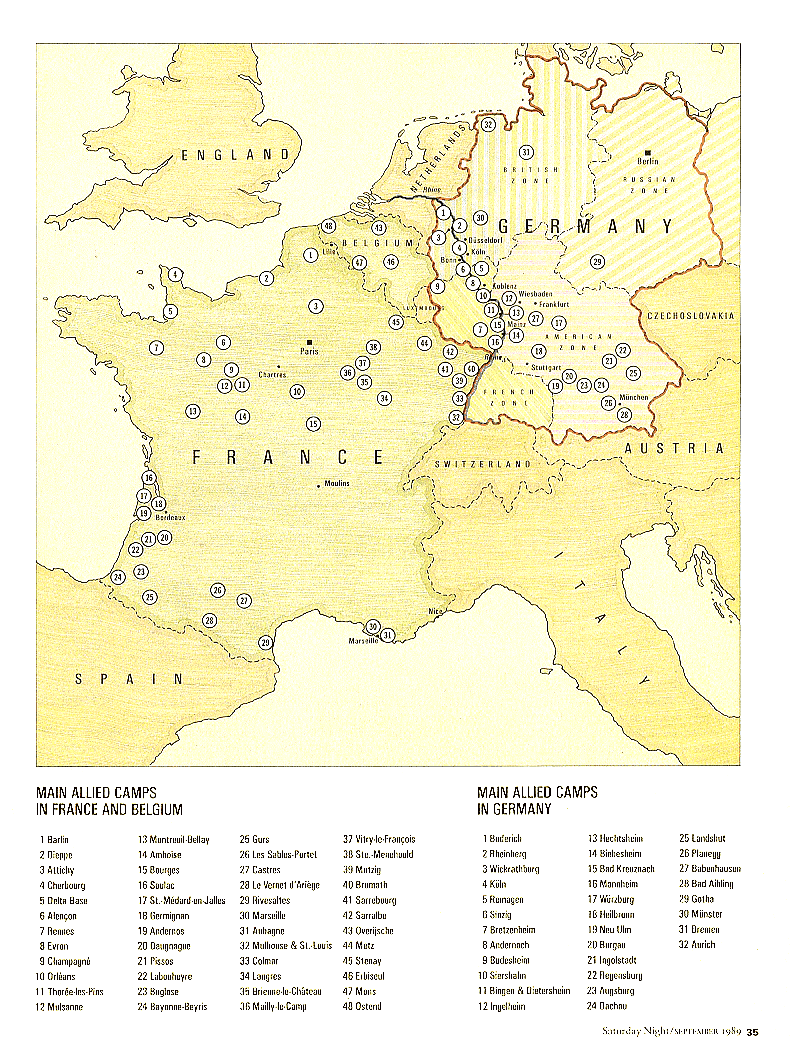
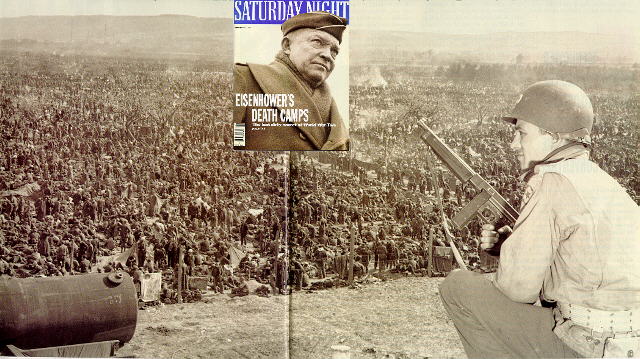
A German newspaper, Rhein-Zeltung has identified this uncaptioned U.S Army photograph of German POWs as : camp at Sinzig-Remagen, spring, 1945
The Last Dirty Secret of World War Two
by James Bacque
Saturday Night
Sept 1989
Call it callousness, call it reprisal, call it a policy of hostile neglect: a million Germans taken prisoner by Eisenhower's armies died in captivity after the surrender.
In the spring of 1945, Adolph Hitler's Third Reich was on the brink of collapse, ground between the Red Army, advancing westward towards Berlin, and the American, British, and Canadian armies, under the overall command of General Dwight Eisenhower, moving eastward over the Rhine. Since the D-Day landings in Normandy the previous June, the westward Allies had won back France and the Low Countries, and some Wehrmacht commanders were already trying to negotiate local surrenders. Other units, though, continued to obey Hitler's orders to fight to the last man. Most systems, including transport, had broken down, and civilians in panic flight fromt he advancing Russians roamed at large.
"Hungry and frightened, lying in grain fields within fifty feet of us, awaiting the appropriate time to jump up with their hands in the air"; that's how Captain H. F. McCullough of the 2nd Anti-Tank Regiment Division described the chaos of the German surrender at the end of the Second World War. In a day and a half, according to Field Marshall Bernard Montgomery, 500,000 Germans surrendered to his 21st Army Group in Northern Germany. Soon after V-E Day--May 8, 1945--the British-Canadian catch totalled more that 2 million. Virtually nothing about their treatment survives in the archives in Ottawa or London, but some skimpy evidence from the International Committee of the Red Cross, the armies concerned, and the prisoners themselves indicates that almost all continued in fair health. In any case, most were quickly released and sent home, or else transferred to the French to help in the post-war work of reconstruction. The French army had itself taken fewer than 300,000 prisoners.
Like the British and Canadians, the Americans suddenly faced astounding numbers of surrendering German troops: the final tally of prisoners taken by the U.S. army in Europe (excluding Italy and North Africa) was 5.25 million. But the Americans responded very differently.
Among the early U.S captives was one Corporal Helmut Liebich, who had been working in an anti-aircraft experimental group at Peenemunde on the Baltic. Liebich was captured by the Americans on April 17, near Gotha in Central Germany. Forty-two years later, he recalled vividly that there were no tents in the Gotha camp, just barbed wire fences around a field soon churned to mud. The prisoners received a small ration of food on the first day but it was then cut in half. In order to get it, they were forced to run a gauntlet. Hunched ocer, they ran between lines of American guards who hit them with sticks as they scurried towards their food. On April 27, they were transferred to the U.S. camp at Heidesheim farther wet, where there was no food at all for days, then very little. Exposed, starved, and thirsty, the men started to die. Liebich saw between ten and thirty bodies a day being dragged out of his section, B, which at first held around 5,200 men.. He saw one prisoner beat another to death to get his piece of bread. One night when it rained, Liebich saw the sides of the holes in which they were sheltered, dug in soft sandy earth, collapse on men who were too weak to struggle out. They smothered before anyone could get to them. Liebich sat down and wept. "I could hardly believe men could be so cruel to each other."
Typhus broke out in Heidesheim about the beginning of May. Five days after V-E Day, on May 13, Liebich was transferred to another U.S. POW camp, at Bingen-Rudesheim in the Rhineland near Bad Kreuznach, where he was told that the prisoners numbered somewhere between 200,000 and 400,000, all without shelter, food, water, medicine, or sufficient space.
Soon he fell sick with dysentery and typhus. he was moved again, semiconscious and delirious, in an open-topped railway car with about sixty other prisoners: northwest down the Rhine, with a detour through Holland, where the Dutch stood on bridges to smash stones down on the heads of the prisoners. Sometimes the American guards fired warning shots near the Dutch to keep them off. After three nights, his fellow prisoners helped him stagger into the hug camp at Rheinberg, near the border with the Netherlands, again without shelter or food.
When a little food finally did arrive, it was rotten. In none of the four camps had Leibich seen any shelter for the prisoners. the death rate in the U.S. Rhineland camps at this point, according to surrviving data from a medical survey, was about thirty per cent per year. A normal death rate for a civilian population in 1945 was between one and two percent.
One day in June, through hallucinations of his fever, Liebich saw "the Tommies" coming into the camp. The British had taken over Rheinberg, and that probably saved his life. At this point, Liebich, who is five-foot-ten, weighed 96.8 ponds.
According to stories told to this day by other ex-prisoners of Rheinberg, tha last act of the Americans before the British took over was to bulldoze one section level while there were still men living in their holes in the ground.
Under the Geneva Convention, three important rights are guaranteed prisoners of war: that they will be fed and sheltered to the same standard as base or depot troops of the Capturing Power; that they can send and receive mail; and that they will be visited by delegates of the International Red Cross (ICRC) who will report in secret on their treatment to a Protecting Power. (In the cas eof Germany, as the government disintegrated in the closing stages of the war, Switzerland had been designated the protecting power.)
In fact, German prisoners taken by the U.S. Army at the end of the Second World War were denied these and most other rights by a series of specific decisions and directives stemming mainly from SHAEF--Supreme Headquarters, Allied Expeditionary Force. General Dwight Eisenhower was both supreme commander of SHAEF--all the Allied armies in northwest Europe--and the commanding general of the U.S. forces in the European theatre. He was subject to the Combined Chiefs of Staff (CCS) of Britain and the U.S., to the U.S. Joint Chiefs of Staff (JCS), and to the policy of the U.S. government, but in the absence of explicit directives--to the contrary or otherwise--ultimate responsibility for the treatment of the German prisoners in American hands lies with him.
"God , I hate the Germans," Eisenhower wrote to his wife, Mamie, in September, 1944. Earlier, in front of the British ambassador to Washington, he had said that all the 3,500 or so officers of the German General Staff should be "exterminated."
In March, 1945, a message to the Combined Chiefs of Staff signed and initialled by Eisenhower recommended creating a new class of prisoners--Disarmed Enemy Forces, or DEFs--who, unlike Geneva-defined prisoners of war, would not be fed by the army after the surrender of Germany. This would be a direct breach of the Geneva Convention. The message, dated March 10, argues in part: "The additional maintenance commitment entailed by declaring the German Armed Forces prisoners [sic] of war which would necessitate the prevision of rations on a scale equal to that of base troops would prove far beyond the capacity of the Allies even if all German sources were tapped." It ends: "Your approval is requested. Existing plans have been prepared upon this basis."
On April 26, 1945, the Combined Chiefs approved the DEF status for prisoners of war in American hands only: the British members had refused to adopt the American plan for their own prisoners. The Combined Chiefs stipulated that the status of disarmed troops be kept secret.
By that time, Eisenhower's quartermaster general at SHAEF, General Robert Littlejohn, had already twice reduced rations for prisoners, and a SHAEF message signed "Eisenhower" had reported to General George Marshall, the U.S. Army Chief of staff, that the prisoner pens would provide "no shelter or other comforts...."
The problem was not supplies. There was more than enough material stockpiled in Europe to construct prison camp facilities. Eisenhower's special assistant, general Everett Hughes, had visited the huge supply dumps at Naples and Marseille and reported: "More stocks than we can ever use. Stretch as far as eye can see." Food should not have been a problem, either. In the U.S., wheat and corn surpluses were higher than they had ever been, and there was a record crop of potatoes. The army itself had so much food in reserve that when a whole warehouse was dropped from the supply list by accident in England it was not noticed for three months. In addition, the International Red Cross had over 100,000 tons of food in storage in Switzerland. When it tried to send two trainloads of this to the American sector of Germany, U.S. Army Officers turned the trains back, saying their warehouses were already overflowing with ICRC food which they had never distributed.
Nonetheless it was through the supply side that the policy of deprivation was carried out. Water, food, tents, space, medicine--everything necessary for the prisoners was kept fatally scarce. Camp Rheinberg, where Corporal Liebich would fetch up in in mid-May, shivering with dysentery and typhus, had no food at all when it was opened on April 17. As in the other big "Rhine meadow" camps, opened by the Americans in mid-April, there were no guard towers, tents, buildings, cooking facilities, water, latrines, or food.
George Weiss, at tank repairman who now lives in Toronto, recalls of his camp on the Rhine: "All night we had to sit up jammed against each other. But the lack of water was the worst thing of all. For three and a half days, we had no water at all. We would drink our own urine...."
Private Heinz T. (his surname is withheld at his request) had just turned eighteen in hospital when the Americans walked into his ward on April 18. he and all his fellow patients were taken out to the camp at Bad Kreuzpath in the Rhineland, which already held several hundred thousand prisoners. Heinz was wearing only a pair of shorts, shoes, and a shirt.
Heinz was far from the youngest in the camp, which also held thousands of displaced German civilians. there were children as young as six among the prisoners, as well as pregnant women, and men over sixty. At the beginning, when trees still grew i the camp, some men managed to cut off limbs to build a fire. the guards ordered the fire put out. In many of the enclosures, it was forbidden to dig holes in the ground for shelter. "All we had to eat was grass," Heinz remembers.
Charles von Luttichau was convalescing at home when he decided to surrender voluntarily to US troops about to occupy his house. He was taken to Camp Kripp, on the Rhine near Remagen.
"We were kept in crowded barbed wire cages in the open with scarcely any food," he recalled recently. "More than half the days we had no food at all. On the rest, we got a little K ration. I could see from the package that they were giving us one-tenth of the rations that they issued to their own men....I complained to the American camp commander that he was breaking the Geneva Convention, but he just said, 'Forget the Convention. You haven't any rights.'
"The latrines were just logs flung over ditches next to the barbed-wire fences. Because of illness, the men had to defecate on the ground. Soon, many of us were too weak to take our trousers off first. So our clothing was infected, and so was the mud where we had to walk and sit and lie down. In these conditions, our men very soon started to die. Within a few days, some of the men who had gone healthy into the camp were dead. I saw our men dragging many bodies to the gate of the camp, where they were thrown loose on top of each other onto trucks, which took them away."
Von Luttichau's mother was American and he later emigrated to Washington, D.C., where he became a historian and wrote a military history for the U.S. Army. he was in the Kripp camp for about three months.
Wolfgang Iff, who was imprisoned at Rheinberg and still lives in Germany, reports that, in his subsection of perhaps 10,000 prisoners, thirty to fifty bodies were dragged out every day. A member of the burial work party, Iff says he helped haul the dead from his cage out to the gate of the camp, where the bodies were carried by wheel barrow to several big steel garages. there Iff and his team stripped the corpses of clothing, snapped off half of their aluminium dog tag, spread the bodies in layers of fifteen to twenty, with ten shovelfuls of quicklime over each layer till they were stacked a metre high, placed the personal efefcts in a bag for the Americans, then left. Some of the corpses were dead of gangrene following frostbite. (It was an unusually wet, cold spring.) A dozen or more others had grown too weak to cling to the log flung across the ditch for a latrine, and had fallen off and drowned.
The conditions in the American camps along the Rhine in late April were observed by two colonels in the U.S. Army Medical Corps, James Mason and Charles Beasley, who described them in a paper published in 1950: "Huddled close together for warmth, behind the barbed wire was a most awesome sight--nearly 100,000 haggard, apathetic, dirty, gaunt, blank-staring med clad in dirty field grey uniforms, and standing ankle-deep in mud....The German Divisions Commander reported that the men had not eaten for at least two days, and the provisions of water was a major problem--yet only 200 yards away was the River Rhine running bankfull."
On May 4, 1945, the first German prisoners of war in U.S. hands were transferred to DEF status. The same day, the U.S. war Department banned mail to or from the prisoners. (when the International Committee of the Red Cross suggested a plan for restoring mail in June, it was rejected.)
On May 8, V-E Day, the German government was abolished and, simultaneously, the U.S. State Department dismissed Switzerland as the protecting power for the German prisoners. (Prime Minister Mackenzie King of Canada protested to the foreign Office in London the parallel removal of the Swiss as protecting power in British-Canadian camps, but was squelched for his pains.) With this done, the State Department informed the International Red Cross that, since there was no protecting power to report to, there was no longer and point in visiting the camps.
From then on, prisoners held by the US Army had no access to any impartial observer, nor could they receive food parcels, clothing, or medicines from any relief agency, or letters from their kin.
general George Patton's US Third Army was the only army in the whole European theatre to free significant numbers of captives during ma, saving many of them from probable death. Bothe Omar Bradley and General J.C.H. lee, Commander Communications Zone (Com Z) Europe, ordered a release of prisoners within a week of the war's end, but a SHAEF order signed "Eisenhower" countermanded them on my 15.
That same day, according to a minute of their meeting, General Eisenhower and Prime Minister Churchill talked about reducing prisoner rations. Churchill asked for an agreement on the scale of rations for prisoners, because he would soon have to announce cuts in the British meat ration and wanted to make sure that the prisoners "as far as possible...should be fed on those supplies which we could best spare." Eisenhower replied that he had already "given the matter considerable attention," but was planning to re-examine the whole thing to see "whether or not a further ereduction was possible." He told Churchill that POWs had been getting 2,200 calories a day. (The US Army medical Corps considered 2,150 an absolute minimum subsistence level for sedentary adults living under shelter. US troops were issued 4,000 calories a day.) What he did not tell Churchill was that the army was not feeding the DEFs at all, or was feeding them far less than those who still enjoyed prisoner-of-war status.
Rations were reduced again soon after this: a direct cut was recorded in the Quartermaster Reports. But indirect cuts were taking place as well. One was the effect of extraordinary gaps between prisoner strength as given on the ration lists and official "on hand" accounts, and between the on-hand counts, and between the on-hand count and the actual number of prisoners in the camps.
The meticulous General Lee grew so worried about the discrepancies that he fired off a challenging cable from his headquarters in paris to SHAEF headquarters in Frankfurt:
"This Headquarters is having considerable difficulty in establishing adequate basis for requisitioning rations for prisoners of war currently held in Theatre...In response to inquiries from this Headquarters...several varying statements of number of prisoners held in theatre have been published by SHAEF."
He then cites the latest SHAEF statement:
"Cable...dated 31 May states 1,890,000 prisoners of war and 1,200,000 disarmed German forces on hand. Best available figures at this Headquarters show prisoners of war in ComZ910,980, in ComZ transient enclosures 1,002,422 and in Twelfth Army GP 965,125, making a total of 2,878,537 and an additional 1,000,000 disarmed German forces Germany and Austria."
The situation was astounding: Lee was reporting a million or more men in the US Army camps in Europe than SHAEF said it ha don its books. But he was wrestling with the wind: he had to his issue of food on the number of prisoners on hand supplied to him by SHAEF G-3 (Operations).
Given the general turmoil, fluctuating and inaccurate tallies were probably inevitable, but more than 1 million captives can actual be seen disappearing between two reports of the Theatre Provost Marshal, issued on the same day, June2. the last in a series of daily reports from the TPM logs 2,870,400 POWs on hand at June 2. The first report of the new weekly series, dated the same day, says that there are only 1,836,000 on hand. At one point in the middle of June, the prisoner strength on the ration list was shown as 1,421,559, while on Lee's and other evidence there were probably almost three times that number.
Spreading the rations thinner was one way to guarantee starvation. Another was accomplished by some strange army bookkeeping during June and July. A million prisoners who had been receiving at least some food because of their nominal POW status lost their rights and their food when they were secretly transferred to the DEF status. The shift was made deliberately over many week, with careful attention paid to maintaining plausible balances in SHAEF's weekly POW and DEF reports. (The discrepancy between those "shifted" from POW status during the period from June 2 to July 28 and those "received" in the DEF status is only 0.43 per cent.) The reclassification to DEF did not require any transfer of men to new camps, or involve any new organisation to get German civilians supplies to them. The men stayed where they were. All that happened was that, by the clatter of a typewriter, their skimpy bit of US Army food was stopped.
The effect of a policy arranged through accountancy and conveyed by winks and nods--without written orders--was first to mystify, then to frustrate, then to exhaust the middle-rank officers who were responsible for POWs. A colonel in the Quartermaster Section of the advance US fighting units wrote a personal plea to Quartermaster General Robert Littlejohn as early as April 27: "Aside from the 750 tons received from Fifteenth Army, no subsistence has been received nor do I expect any. What desirable Class II and IV (rations) we have received has been entirely at the suffernece of the Armies, upon personbal appeal and has been insignificant in relation to the demands which are being put upon us by the influx of prisoners of war."
Rumours of conditions in the camps ran through the US Army. "Boy, those camps were bad news," said Benedict K. Zobrist, a technical sergeant in the Medical Corps. "We were warned to stay as far away as we could." In May and early June of 1945, a team of US Medical Corps doctors did survey some of the Rhineland camps, holding just over 80,000 German POWs. Its report is missing from the appropriate section of the National Archives in Washington, but two secondary sources reproduce some of the findings. The three main killers were diarrhoea and dysentery (treated as one category), cardiac disease, and pneumonia. But, straining medical terminology, the doctors also recorded deaths from "emaciation" and "exhaustion." And their data revealed death rates eighty times as high as any peacetime norm.
Only 9.7 percent to fifteen percent of the prisoners had died of causes clearly associated with lack of food, such as emaciation and dehydration, and "exhaustion." But the other diseases, directly attributable to exposure, overcrowding, filth, and lack of sanitation, were undoubtedly exacerbated by starvation. As the report noted, "Exposure, overcrowding of pens and lack of food and sanitary facilities all contributed to these excessive (death) rates." The data, it must be remembered, were taken from the POW camps, not from the DEF camps.
By the end of May,1945, more people had already died in the US camps than would die in the atomic blast at Hiroshima.
On June 4, 1945, a cable signed "Eisenhower" told Washington that it was "urgently necessary to reduce the number of prisoners at earliest opportunity by discharging all classes of prisoners not likely to be required by Allies." It is hard to understand what prompted this cable. No reason for it is evident in the massive cable traffic that survives the period in the archives in London, Washington, and Abilene, Kansas. And far from ordering Eisenhower to take or hold on to prisoners, the Combined Chiefs' message of April 26 had urged him not to take in any more after V-E Day, even for labour. Nonetheless more than 2 million DEFs were impounded after May 8.
During June, Germany was partitioned into zones of occupation and in July, 1945, SHAEF was disbanded. Eisenhower, reverting to his single role as US commanding general in Europe, becoming military governor of the US zone. He continued to keep out Red Cross representatives, and the US Army also informed American relief teams that the zone was closed to them. It was closed to all relief shipments as well--until December, 1945, when a slight relaxation came in to effect.
Also starting in July, the Americans turned over between 600,000 and 700,000 German captives to the French to help repair damages done to their country during the war. many of the transferees were in five US camps clustered around Dietersheim, near Mainz, in the section of Germany that had just come under French control. (most of the rest were in US camps in France.)
On July 10, a French unit took over Dietersheim and seventeen days later a Captain Julien arrived to assume command. His report survives as part of an army inquiry into a dispute between Julien and his predecessor. In the first camp he entered, he testified to finding muddy ground "people living skeletons," some of whom died as he watched. others huddled under bits of cardboard which they clutched although the July day was hot. Women lying in holes in the ground stared up at him with hunger oedema bulging their bellies in gross parody of pregnancy; old men with long grey hair watched him feebly; children of six or seven with the racoon rings of starvation looked at him from lifeless eyes. Tow German doctors in the "hospital" were trying to care for the dying on the ground under the hot sky, between, the marks of the tent that the Americans had taken with them. Julien, who had fought against the Germans with his regiment, the 3erne Regiment de Tirailleure Algeriens, found himself thinking in horror: "This is just like the photographs of Buchenwald and Dachau."
There were 103, 500 people in the five camps round Dietersheim and amongst them Julien's officers counted 32, 640 who could do no work at all. These were released immediately. In all, two-thirds of the prisoners taken over by the French that summer from American camps in Germany and in France were useless for reparations labour. In the camp at Sainte-Marthe, 615 of 700 captives were reported to be unable to work. At Erbiseul near Mons, Belgium, according to a written complaint, twenty-five per cent of the men received by the French were "dechets," or garbage.
In July and August, as US Quartermaster Littejohn signalled to Eisenhower in due course, the Army food reserves in Europe grew by thirty-nine percent.
On August 4, a one-sentence order signed "Eisenhower" condemned all prisoners of wear still on hand in the US camps to DEF status: "Effective immediately all members of the German forces held in US custody in the American zone of occupation in GERMANY will be considered as disarmed enemy forces and and not as having the status of prisoner of war." No reason was given. Surviving weekly tallies suggest the dual classification was preserved, but, for the POWs now being treated as DEFs, the death rate quadrupled within a few weeks, from .2 percent per week to .8 percent.
Long-time DEFs were dying at nearly five times that rate. the official "Weekly PW and DEF Report" for the week ending Sept 8, 1945, still exists in the US National archives in Washington. It shows an aggregate of 1,056,482 prisoners being held by the US Army in the European theatre, of whom about two-thirds are identified as POWs. the other third--363,587 men--are DEFs. During that one week, 13,051 of them died.
In November, 1045, general Eisenhower succeeded George Marshall as US Army chief of staff and returned to the US. In January, 1946, the camps still held significant numbers of captives but the US had wound down its prisoner holdings almost to zero by the end of 1946. the French continued holding hundreds of of thousands through 1946, but gradually reduced the number to nothing by about 1949. During the 1950's, most non-record material relating to the US prison camps was destroyed by the Army.
Eisenhower had deplored the Germans' useless defence of the Reich in the last months of the war because of the waste of life. At least ten times as many Germans--undoubtedly 800,000, almost certainly more than 900,000, and quite probably over 1 million--died in the French and American camps as were killed in all the combat on the Western Front in northwest Europe from America's entry into the war in 1941 through to April, 1945.




A German newspaper, Rhein-Zeltung has identified this uncaptioned U.S Army photograph of German POWs as : camp at Sinzig-Remagen, spring, 1945
_________________
All about Shillaphobia
Shun the non-believers!
'Flat Earth Diva'
Supposed 'temper temper beanpole', 'snidy weasel' and 'clueless, cloying, sychophant.'
Apparently 'dangerous person'
Thinkforyourself- Admin
- Posts : 2048
Points : 8347
Reputation : 2862
Join date : 2015-12-30
Age : 36
Location : United Kingdom
 Re: Hellstorm: Exposing The Real Genocide Of Hitler's Germany
Re: Hellstorm: Exposing The Real Genocide Of Hitler's Germany
You ! sit right there and guard 'em boy
But.. they don't have any shelter let alone toilets
No water either ! until it snows' just don't let any get away k boy !
But.. they don't have any shelter let alone toilets
No water either ! until it snows' just don't let any get away k boy !

Spöket- Posts : 4
Points : 2863
Reputation : -1
Join date : 2017-01-28
Age : 47
Location : Australien
 Re: Hellstorm: Exposing The Real Genocide Of Hitler's Germany
Re: Hellstorm: Exposing The Real Genocide Of Hitler's Germany
Original videos gone.
Hellstorm can be watched here:
https://www.bitchute.com/video/17nypWABfsmu/?list=dcd8OtPzhLre&randomize=false
Hellstorm can be watched here:
https://www.bitchute.com/video/17nypWABfsmu/?list=dcd8OtPzhLre&randomize=false
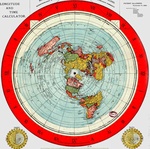
Tiwar- Posts : 17
Points : 2926
Reputation : 9
Join date : 2016-12-19
Location : AU
 Re: Hellstorm: Exposing The Real Genocide Of Hitler's Germany
Re: Hellstorm: Exposing The Real Genocide Of Hitler's Germany
Tiwar wrote:Original videos gone.
Hellstorm can be watched here:
https://www.bitchute.com/video/17nypWABfsmu/?list=dcd8OtPzhLre&randomize=false
and here:
https://odysee.com/Hellstorm_Documentary_EN_with_SE_subtitles_v2:77d1f38d6af5e1b2a9098f3df08e9d6cca2eaa58?src=embed
notdownunder and tycho_brahe like this post
 Re: Hellstorm: Exposing The Real Genocide Of Hitler's Germany
Re: Hellstorm: Exposing The Real Genocide Of Hitler's Germany
with the link provided below, you will be able to find a playlist (on odysee) with all the videos mentioned in the "you watch, you decide" list.
Which contains the following documentaries:
- Marching to zion
- adolf hitler vs jew world order
- eisenhower's rhine meadows death camps
- EUF-6,000,000 LIES
- hellstorm
- hitler, the greatest story never told
- hitler's war, what the historians neglect to mention
- judea declares war on Germany
- nwo, communism by the backdoor
- one third of the holocaust
- six million jews 1915-1938
- the jewish gas chamber hoax
- the majdanek gas chamber myth
- the treblinka archeology hoax
for the sake of easy access
https://odysee.com/@MaxMees:7/You-watch%2C-You-decide:2?r=H5K2R9T4vZH4i7yycGZvQyAFnCgiYeui&lid=2116d29c22f2b9fd83e1ab2dd7a8373884ad0b03
Which contains the following documentaries:
- Marching to zion
- adolf hitler vs jew world order
- eisenhower's rhine meadows death camps
- EUF-6,000,000 LIES
- hellstorm
- hitler, the greatest story never told
- hitler's war, what the historians neglect to mention
- judea declares war on Germany
- nwo, communism by the backdoor
- one third of the holocaust
- six million jews 1915-1938
- the jewish gas chamber hoax
- the majdanek gas chamber myth
- the treblinka archeology hoax
for the sake of easy access
https://odysee.com/@MaxMees:7/You-watch%2C-You-decide:2?r=H5K2R9T4vZH4i7yycGZvQyAFnCgiYeui&lid=2116d29c22f2b9fd83e1ab2dd7a8373884ad0b03
FE_AirlinePilot likes this post
 Re: Hellstorm: Exposing The Real Genocide Of Hitler's Germany
Re: Hellstorm: Exposing The Real Genocide Of Hitler's Germany
MMDC wrote:with the link provided below, you will be able to find a playlist (on odysee) with all the videos mentioned in the "you watch, you decide" list.
Which contains the following documentaries:
- Marching to zion
- adolf hitler vs jew world order
- eisenhower's rhine meadows death camps
- EUF-6,000,000 LIES
- hellstorm
- hitler, the greatest story never told
- hitler's war, what the historians neglect to mention
- judea declares war on Germany
- nwo, communism by the backdoor
- one third of the holocaust
- six million jews 1915-1938
- the jewish gas chamber hoax
- the majdanek gas chamber myth
- the treblinka archeology hoax
for the sake of easy access
Marching to Zion is great and Pastor Anderson also made a quick 35min video fairly Christian normie friendly debunking the holohoax: bitchute.com/video/gtzjQ2Xx1JDO/
The great WWII researcher David Irving also have some good gems which are getting harder to find:
bitchute.com/video/Fr3XnxaFKNQM/ (DAVID IRVING THE HOLOCAUST LIE - THE BIGGEST LIE 1995)
bitchute.com/video/ynVnqmoBB3ng/ (6,000,000 DEBUNKED IN 3 MINUTES AND 35 SECONDS)
I also need to find some of the old 1980s Professeur Faurisson conferences and documentaries, he was so good that they passed the Loi Gayssot in French specifically to prevent him from continuing his work. A lot of it is in French and hasn't been translated but he really was one of the great holocaust expert along with Irving
Here's one of them, bitchute.com/video/8xPkRhyWqRg0/ (ROBERT FAURISSON - L'EXISTENCE DES CHAMBRES À GAZ)
Another good documentary that was mainstream produced but accidentally revealed the state of pre NSDAP Berlin in the Weimar republic bitchute.com/video/YVl9vzcrNFTz/ (BABYLON BEFORE HITLER)
FE_AirlinePilot- Posts : 10
Points : 852
Reputation : 0
Join date : 2022-08-11
 Similar topics
Similar topics» CoronaVirus and Forced Vaccination Manipulation
» The International JEW -The World's Foremost PROBLEM
» Direct Vision, Rationality, Realism and Common Sense.
» Flat Earth and Project Blue Beam
» The Real Purpose of TFE (imo)
» The International JEW -The World's Foremost PROBLEM
» Direct Vision, Rationality, Realism and Common Sense.
» Flat Earth and Project Blue Beam
» The Real Purpose of TFE (imo)
IFERS - Exposing the 'Global' Conspiracy From Atlantis to Zion :: NASA, UN, Freemasonry, Vatican, Jews, Jesuits, NWO
Page 1 of 1
Permissions in this forum:
You cannot reply to topics in this forum